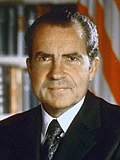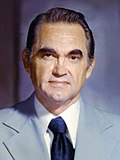| |||||||||||||||||||||||||||||||||||||
| Turnout | 59.7%[1] | ||||||||||||||||||||||||||||||||||||
|---|---|---|---|---|---|---|---|---|---|---|---|---|---|---|---|---|---|---|---|---|---|---|---|---|---|---|---|---|---|---|---|---|---|---|---|---|---|
| |||||||||||||||||||||||||||||||||||||
 County Results
| |||||||||||||||||||||||||||||||||||||
| |||||||||||||||||||||||||||||||||||||

| Elections in New York State |
|---|
 |
The 1968 United States presidential election in New York took place on November 5, 1968. All 50 states and the District of Columbia, were part of the 1968 United States presidential election. Voters chose 43 electors to the Electoral College, which selected the president and vice president.
New York was won by incumbent Democratic vice president Hubert Humphrey, defeating Republican former vice president Richard Nixon by a margin of 5.46 percentage points and more than 370,000 votes. Maine Senator Edmund Muskie was Humphrey’s vice-presidential running mate, while Nixon’s running mate was Maryland Governor Spiro Agnew.
Humphrey took 49.76% of the vote to Nixon's 44.30% in New York, while former Alabama Governor George Wallace won 5.29% as the nominee of the American Independent Party. Wallace ran a segregationist and right-wing populist campaign which failed to gain much traction in the Northeast. Wallace did best in suburban and exurban counties, as well as in the New York City borough of Staten Island. Wallace's stances were popular with voters who resented race riots, the increasing influence of African-Americans in the national Democratic Party, and the counterculture, but were anathema to voters in the inner cities and most of Upstate New York.[3]
New York weighed in for this election as 7% more Democratic than the nation. Almost six percent of the electorate voted for third parties, mainly the American Independent Party.[4] In typical form for the time, the major cities of New York City, Buffalo, Albany, Schenectady, and Niagara Falls voted Democratic, while the smaller counties in New York mainly turned out for Nixon as the Republican candidate. Nixon thus became the first Republican to win the White House without carrying Erie County since Abraham Lincoln in 1864, the first to do so without carrying Niagara or Schenectady Counties since Rutherford B. Hayes in 1876, as well as the first to do so without carrying Albany or Queens Counties since Herbert Hoover in 1928.
Despite Nixon winning most of the state's counties, Humphrey’s landslide margin in New York City — receiving 60.6% of the vote in the five boroughs to Nixon's 33.9%, and losing only Staten Island to Nixon — provided him with enough raw votes for a statewide victory. Humphrey was seen by many as promising to continue the legacy of president Lyndon B. Johnson,[5] and this garnered him strong support from liberal voters across America.
This was the first time since Samuel J. Tilden won the state in 1876 that New York voted for a losing Democratic candidate. As of 2020[update], this remains the last time that New York had the largest number of electoral votes in the nation, as California would overtake it after the 1970 census.[6] Nixon is one of four presidents to win the presidency while losing his home state (the others being James K. Polk with Tennessee in 1844, Woodrow Wilson with New Jersey in 1916, and Donald Trump with New York in 2016).
- ^ Bicentennial Edition: Historical Statistics of the United States, Colonial Times to 1970, part 2, p. 1072.
- ^ "Courage Party in State Wants Wallace on Ballot". The New York Times. June 18, 1972. Retrieved March 21, 2017.
- ^ Phillips; The Emerging Republican Majority, p. 10
- ^ "1968 Presidential General Election Results — New York". Dave Leip's Atlas of U.S. Presidential Elections. Retrieved January 9, 2018.
- ^ Lewis L. Gould (2010). 1968: The Election That Changed America. Government Institutes. pp. 16-18.
- ^ "New York — CountingTheVotes.com". January 6, 2017. Archived from the original on January 6, 2017. Retrieved August 13, 2022.
{{cite web}}: CS1 maint: bot: original URL status unknown (link)
Cite error: There are <ref group=lower-alpha> tags or {{efn}} templates on this page, but the references will not show without a {{reflist|group=lower-alpha}} template or {{notelist}} template (see the help page).
© MMXXIII Rich X Search. We shall prevail. All rights reserved. Rich X Search



